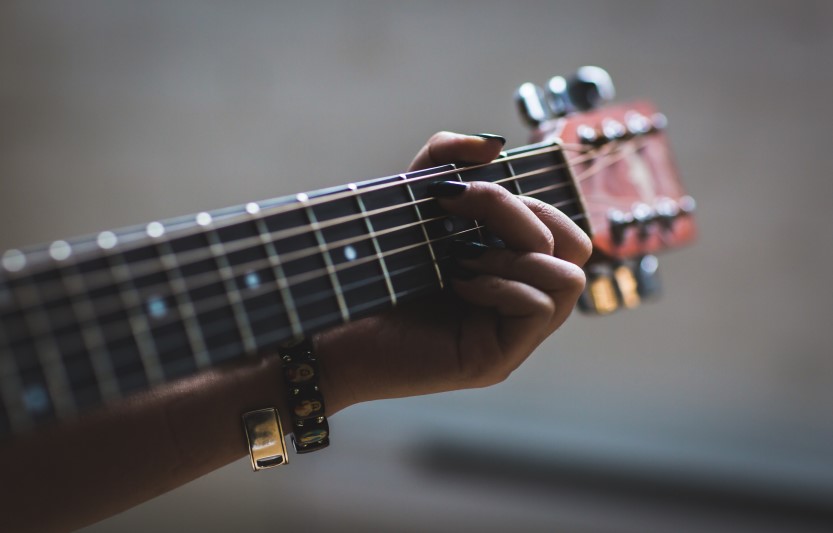
Have you ever wondered what are guitar arpeggios? As guitar players, we hear about arpeggios constantly. Their importance cannot be overstated.
As a matter of fact, arpeggios can make up a huge chunk of guitar music.
Guitar heroes from different styles have a deep understanding of arpeggios and can play them all over the neck. From Joe Bonamassa to Pat Metheny, arpeggios are a fundamental aspect of guitar playing. Along with scales, arpeggios are among the first things you learn if you want to take the guitar seriously.
Check out Roadie Coach for a fantastic tool to help you with your progress. It features a chord and scale directory, which will be a great aid when learning arpeggios as well. So without further ado, let’s learn what are guitar arpeggios.
Chords
Before talking about arpeggios, we need to address chords.
A common definition of chords is “three or more musical tones played simultaneously”. In other words, any three notes sounding at the same time make up a chord.
However, even though you can pick three random notes on a guitar to create harmony, chords are not built randomly. It is quite the opposite.
How chords are created
Chords are likely the very first thing you are going to learn on guitar. You’ll start with some easy ones and then move on to the complicated stuff.
The vast majority of chords are constructed using the first, third and fifth notes of a given scale. Don’t stress just yet, I promise it’s easy to understand.
Let’s take the C major scale, which most of us learned in kindergarten. It is composed of the notes C, D, E, F, G, A, B. On that sequence, the first note is a C, the third is an E and the fifth is a G. Those three notes make up the C major chord.
How are arpeggios created?
Let’s stay with the three mentioned notes of the C major scale. Play them (C, E and G) at the same time. Done? Well, you just played a chord.
Now, let’s play them one after the other. First play a C, followed by a E and then an G. Done? You just played an arpeggio. If you are asking yourself if it really is that simple the answer is yes.
An arpeggio is made up of notes from a chord played individually, instead of together. Arpeggios are sometimes referred to as broken chords.
Arpeggios are simple
The theory behind arpeggios is simple. If you can figure out chords, you can figure out arpeggios. The real challenge arises when you want to learn them in all positions all over the guitar neck. Add to that learning different types of arpeggios, and you’ve got your work cut out for you. But it is well worth it.
As you may have inferred, arpeggios are very closely related to scales and chords. You can figure out how to come up with basic arpeggios by taking the scale in question.
For instance, let’s the A minor chord. The notes on it are A, C, and E. Why, you might ask. Because those are the first, third, and fifth notes on the A minor scale (A, B, C, D, E, F, G).
I understand that this may sound a bit complicated, but it gets easier. For now, just understand that arpeggios are made of chord tones played individually.
What are arpeggios used for
You have probably heard tons of songs that feature arpeggios. For instance, take the Guns N’ Rose classic “Don’t Cry”. It features a beautiful progression played with arpeggios for each chord.
Basically, instead of strumming, Slash is playing the song by arpeggiating the chords. That just means he is playing the notes separately.
Another great song that uses arpeggios from the start is “Mamma I’m Coming Home” by Ozzy Osbourne. Take a listen and notice how each note follows the other to create a beautiful sequence that delineates the chods.
Another common use for arpeggios is on guitar solos. How much of this tool is used on solos depends on the player on the style. That being said, know that professional guitar players spend a considerable amount of time working on arpeggios. These are considered a cornerstone of music, and this is especially true for guitar players.
How to learn arpeggios
You can start off by learning major and minor arpeggios first. The process is very similar to learning chords. You begin with the easy ones, just simple triads that are either major or minor.
And just like with chords, you can then move on to arpeggios that have four notes and learn them all over the fretboard.
Take the time to learn them in different shapes and positions, much like you would with scales. Naturally, this process will take some time, but it will pay massive dividends.
The answer to what are guitar arpeggios is quite simple. The challenge lies in learning them and making them an integral part of your playing.
Simply said, arpeggios are a major part of becoming a guitar player. They form the building blocks of technique and will help you understand harmony more linearly.
Like most things guitar-related, it takes time to get good at arpeggios. Practicing constantly is the best way to learn and understand them. A word of caution though: if you just started playing guitar, you may want to work on chords and strumming patterns before arpeggios.
Then again, perhaps you’d like an extra challenge to spice up your days. If that’s the case, then arpeggios are for you. Remember to have fun.


